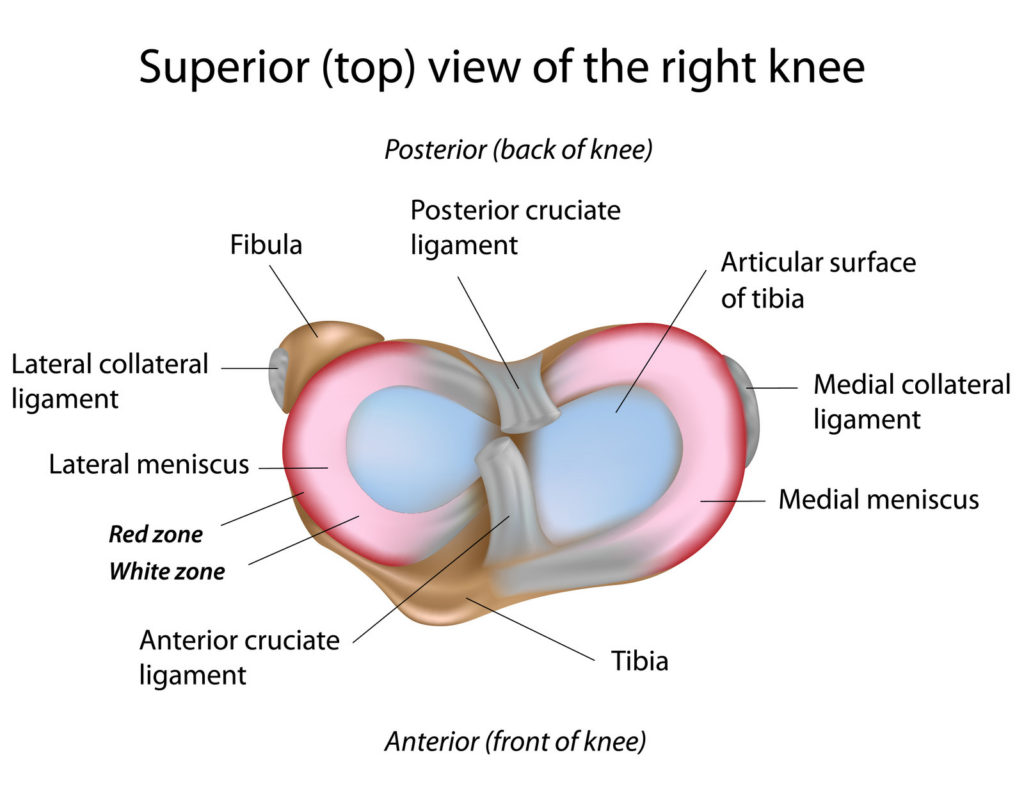If you are a patient suffering with long-term knee problems caused by a damaged or surgically removed meniscus, you have likely been made aware that your meniscus, or what remains of it, has a limited capacity to repair itself. You may have also been made aware that meniscus related surgery also has a limited capacity to improve your situation.
If you were given a realistic assessment of your meniscus situation, you were told that osteoarthritis, degenerative knee disease, and possibility of knee replacement were the ultimate outcomes.
This is why researchers are looking at stem cells injections
Stem Cell Therapy is part of a family of treatments that fall under the broad umbrella of “Tissue Engineering” or “Regeneration or Regenerative Therapy.” In recent medical papers, doctors say that the future of meniscus repair is not in surgery, but meniscus tissue engineering and that more research should be given towards maximizing the healing/regenerative properties of stem cells.1
Stem cell therapy is a highly effective treatment in which stem cells are injected into an injured area. At the Magaziner Center, we use Mesenchymal stem cells (MSCs) for our stem cell therapy injections. Stem cells are responsible for rebuilding and regenerating the body. They are living cells that are able to transform themselves into many different types of tissue, and are therefore able to differentiate into ligaments, tendons, bone, nerve, and cartilage.
How stem cell injections addresses meniscus injury
The problem with the meniscus is that it is divided into zones. The outer area that gets a steady blood supply (Red Zone) and has a capacity for healing. The middle area the “Red-White” zone that has limited blood supply and is more challenging to heal, and the avascular zone or the “White zone,” which is thought that repair cannot be made because it has no direct blood supply.
In new studies doctors in China declare that: “The repair of meniscus tissue in the avascular zone (without blood vessels to bring healing components) remains a great challenge, largely owing to their limited healing capacity.” The answer they suggest to heal this area lies with stem cell based tissue engineering. Stem cells, they write, “provide a promising treatment option for damaged meniscus because of their multiple differentiation potential (their ability to change into meniscal and cartilage cells).”2
In new research, scientists looked at rabbits with massive meniscal defects. Their goal was to see if a single stem cell injection would improve the defect. This is what the researchers wrote: “(stem cells) injected into the knee adhered around the meniscal defect, and promoted meniscal regeneration in rabbits.” This also lead to a preservation of the articular cartilage and subchondral bone.3
Doctors at Harvard University found unique characteristics in the stem cells of mice meniscus that could be reawakened by stem cell augmentation. The findings were so optimistic that the Harvard team declared that studying the mouse meniscal stem cells would provide essential information for enhancing therapeutic strategies for treating knee joint injury and disease.4
This agrees with other research which strongly supports Stem Cell Therapy as a means to regrow meniscal tissue. From the American Journal of Bone and Joint Surgery:
- There are limited treatment options for tissue restoration and the prevention of degenerative changes in the knee.
- Stem cells have been a focus of intense preclinical research into tissue regeneration but limited clinical investigation.
- In a randomized, double-blind, controlled study, the safety of the intra-articular injection of human mesenchymal stem cells into the knee, the ability of mesenchymal stem cells to promote meniscus regeneration following partial meniscectomy, and the effects of mesenchymal stem cells on osteoarthritic changes in the knee were investigated . . .
- There was evidence of meniscus regeneration and improvement in knee pain following treatment with mesenchymal stem cells.
- These results support the study of human mesenchymal stem cells for the apparent knee-tissue regeneration and protective effects.5
1 W, Guo W, Han S, Zhu Y, Liu S, Guo Q. Cell-Based Strategies for Meniscus Tissue Engineering. Stem Cells International. 2016;2016:4717184. doi:10.1155/2016/4717184.
2. Hana Yu, Adetola B Adesida and Nadr M Jomha1. Meniscus repair using mesenchymal stem cells – a comprehensive review.Stem Cell Research & Therapy 2015, 6:86 doi:10.1186/s13287-015-0077-2
3. Hatsushika D, Muneta T, Horie M, Koga H, Tsuji K, Sekiya I. I Intraarticular injection of synovial stem cells promotes meniscal regeneration in a rabbit massive meniscal defect model. J Orthop Res. 2013 Sep;31(9):1354-9. doi: 10.1002/jor.22370. Epub 2013 Apr 17.
4. Gamer LW, Shi RR, Gendelman A, et al. Identification and characterization of adult mouse meniscus stem/progenitor cells.Connect Tissue Res. 2016 Dec 22:1-8. doi: 10.1080/03008207.2016.1271797.
5.Vangsness CT Jr, Farr J , Boyd J et al. Adult human mesenchymal stem cells delivered via intra-articular injection to the knee following partial medial meniscectomy: a randomized, double-blind, controlled study. J Bone Joint Surg Am. 2014 Jan 15;96(2):90-8. doi: 10.2106/JBJS.M.00058.
5. Sihvonen R, Paavola M, Malmivaara A, Itälä A, Joukainen A, Nurmi H, Kalske J, Järvinen TL; Finnish Degenerative Meniscal Lesion Study (FIDELITY) Group. Arthroscopic partial meniscectomy versus sham surgery for a degenerative meniscal tear. N Engl J Med. 2013 Dec 26;369(26):2515-24. doi: 10.1056/NEJMoa1305189.
